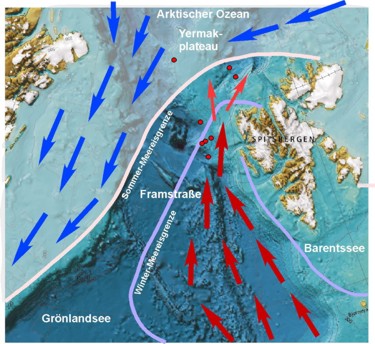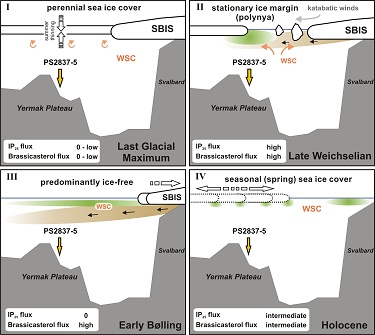|
Holocene variability in the Arctic gateway
Principal Investigators: Matthias Prange (University of Bremen), Robert Spielhagen (IFM-GEOMAR), Martin Frank (IFM-GEOMAR), Gerrit Lohmann (AWI Bremerhaven), Rüdiger Stein (AWI Bremerhaven)
Project Scientists: Juliane Müller (AWI Bremerhaven), Axel Wagner (AWI Bremerhaven), Kirstin Werner (IFM-GEOMAR)
Fig. 1: Working area of the HOVAG project: In the eastern Fram Strait, relatively warm Atlantic Water enters the Arctic Ocean (red arrows), while a perennial ice cover and cold surface waters characterize the East Greenland Current (blue arrows). Red dots mark locations of sediment cores analyzed in this study.
Fig. 2: Distinct sea ice conditions in northern Fram Strait as inferred from biomarker data (IP25 sea ice proxy and phytoplankton derived brassicasterol) during the past 30,000 years (Müller et al., 2009).
Multiproxy studies on high-resolution sediment cores from eastern Fram Strait – the only deep-water connection between the Arctic and the Atlantic Ocean (Fig. 1) – allow for palaeoenvironmental reconstructions of the past 10,000 years and beyond. The main focus is to determine the natural variability of the Atlantic Water inflow to the Arctic Ocean, the position of the sea ice margin, and the structure of the water column.
The results of sedimentological, micropalaeontological and organic geochemical studies are comparatively linked to numerical modelling experiments. As such we, for instance, successfully traced and simulated recent sea ice conditions in the northern North Atlantic on base of proxy and modelling datasets (manuscript in preparation).
By means of the biomarker composition of a sediment core (PS2837-5) in northern Fram Strait, we provided insight into variable sea ice conditions as they likely prevailed during the past 30,000 years BP due to a fluctuant warm Atlantic water advection (Fig. 2; Müller et al., 2009).
Furthermore, we suggest a general Holocene cooling trend from increasing sea ice proxy (IP25) abundances, rising IRD contents and planktic foraminiferal data (δ13C values, species assemblages) since about 5,000 years BP. This is also confirmed by results of numerical time-slice experiments using the regional ocean sea-ice model NAOSIM. The simulated sea surface temperatures and sea ice conditions are consistent with the results of the proxy studies.
A high-resolution stratigraphy of the analysed sediment cores (Fig. 1) was established by AMS-14C measurements. Sedimentological and micropaleontological work regards grain size determinations, the content of planktic and benthic foraminifers, and the analysis of planktic foraminiferal associations. Oxygen and carbon isotopic compositions of planktic and benthic foraminifers (by mass spectrometry), as well as ratios of Nd and Pb isotopes (by MC-ICPMS) are determined. Organic geochemical work includes bulk sediment analyses (TOC, TC, TN by LECO technique, Rock-Eval measurements). Additionally, biomarker lipids (e.g. IP25 sea ice proxy, phytoplankton sterols, terrigenous derived n-alkanes) are determined using gas chromatography (GC), gas chromatography/mass spectrometry (GC/MS). Compound-specific carbon isotope measurements of selected samples will be performed.
The modelling studies are carried out by means of the regional ocean-sea ice model NAOSIM with a horizontal resolution of 0.25°. The domain covers the Arctic Ocean and adjacent seas. As atmospheric forcing fields, we reproduced high-resolution atmospheric simulations with the general circulation models COSMOS, CCSM and ECHOG with a horizontal resolution of T106 (1.1°) and 31 vertical levels. Furthermore the terrestrial Arctic river runoff into the Arctic ocean has been analysed by transient ECHO-G simulations.
Archives
Sediment cores for studies within HOVAG were obtained by RV "Maria S. Merian" during leg MSM05/5b in August 2007. Older cores from several RV "Polarstern cruises" to the Yermak Plateau are also available.
References
Müller, J., Massé, G., Stein, R. and Belt, S.T., 2009. Variability of sea-ice conditions in the Fram Strait over the past 30,000 years. Nature Geoscience, 2(11): 772-776. http://doi.pangaea.de/10.1594/PANGAEA.728973
|
| < Prev | Next > |
|---|



